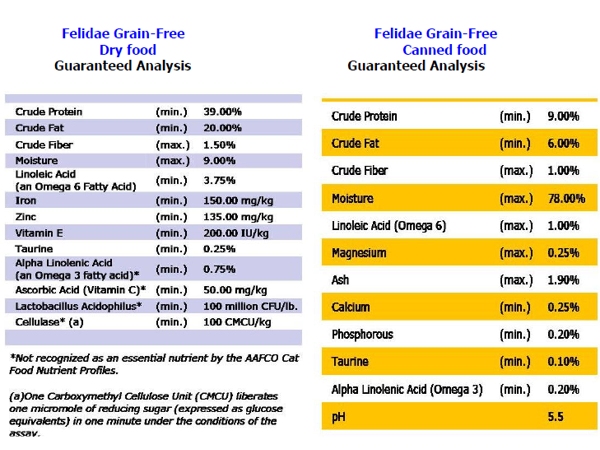Guaranteed AnalysisThe purpose of the Guaranteed Analysis (GA) on pet food labels is to place a value on four main nutrients - Protein, Fat, Fiber and Moisture. Many state regulations require pet foods to guarantee the minimum percentages of crude protein and crude fat, and the maximum percentages of crude fiber and moisture. Pet food manufacturers often include other measurable nutrients that are of importance to pet owners. The GA provides valuable information and is a reliable way to compare two or more pet foods. Guaranteed Analysis refers to the "as fed" or "as is" basis. This means the amounts listed on the GA label are present just as they are found in the can or bag. (It does not mean those specific amounts are fully bio-available to your pet). When comparing the GA between dry and canned products, notice that the levels of crude protein and most other nutrients are much lower for the canned product. This is because canned food is 75-80% water. Dry foods usually contain 10-12% water.
Using the two Guaranteed Analysis statements above on Felidae Grain-Free cat food, ATG will show you how to calculate the dry matter basis. The formula is 100 – percent moisture = dry matter. • This canned cat food has 78% moisture. 100 – 78 = 22% dry matter Now that you know the dry matter basis for both products, you can make accurate comparisons of all of the listed nutrients. We will start by showing you how to calculate the dry matter basis of protein in these two foods. To convert the protein of the canned food to dry matter basis simply divide the reported amount of protein - in this case, 9% by the total amount of dry matter, 22% and then, multiply by 100. • Here is the formula for the canned food: (9/22) x 100 = 40.9%. That is quite a difference from the 9% protein value that appears on the GA of the canned food! Convert the protein percentage of the dry food to dry matter basis the same way. Again, divide the amount of protein - 39% by the amount of dry matter, 91% then multiply by 100. • Here is the formula for the dry cat food: (39/91) x 100 = 42.9%. By calculating dry matter basis, the percentage is more accurate than the 39% minimum amount stated on the Guaranteed Analysis.
Most pet food products do not outwardly state the amount of carbohydrates the food contains. Concerned pet owners must perform the calculations themselves. Fortunately, the pet food labels give you all the information you need to do so accurately. Protein, Fat, Moisture and Fiber are the four main measurable values of pet food. Ash levels are on some labels, especially cat food. Ash consists of the inorganic mineral content (Calcium, Phosphorous, Iron, Zinc, Selenium and others) left over when the organic portion of the food has been burned off. Ash is part of the formula when determining carbohydrate percentage in pet food. Here is the FDA’s recommended carbohydrate calculation formula. Subtract the percent of crude protein, total fat, moisture, and ash from 100. (100% - % protein - % fat - % moisture - % ash = Carbohydrate) *Do NOT subtract the fiber when calculating carbohydrate totals. Fiber IS a carbohydrate. Using the GA of the Felidae dry cat food above, we can now calculate the percentage of carbs. To compare carbohydrate content in dry and wet foods you must first convert percentages to the dry matter basis for each nutrient - protein, fat, carbohydrate and ash. Canned Felidae is 22% dry matter. From our previous calculations, we found the dry matter basis of protein in the canned product to be 40.9%. Now we will figure the dry matter (DM) basis of fat and ash (not the fiber because it is a carbohydrate). • Fat: (6/22) x 100 = 27% DM and Ash: (1.9/22) x 100 = 8.6% DM • Now, the carbohydrate formula: 100% - 40.9% Protein – 27% Fat – 8.6% Ash = 23.5% carbohydrates in the canned cat food. Canned food generally contains fewer grains therefore less carbs. Please understand that while it may look like a scientific statement of product effectiveness, the Guaranteed Analysis chart really only represents the food's minimum amount of protein and fat, and the maximum amount of fiber and water. The GA makes no statement as to whether or not your pet's body can absorb and use the nutrients provided because it is determined on the ‘as fed’ basis. The bottom line is - Do not take marketing claims at face value or believe everything you read on a bag of pet food. The only reliable indicator of quality is the ingredients list.
Against The Grain Pet Nutrition is a company that does things differently. We are a small business that is excited about offering pet owners better choices in pet nutrition. We believe that choosing appropriate pet food (be it commercial, raw or home prepared) is the most important factor in any pet's preventative health, convalescence and longevity. Our name - Against The Grain - reflects our strong passion to provide pet owners with the knowledge to make healthy decisions about pet care even if we go ‘against the grain' of popular thinking. 
 To contact us:
To contact us:www.ATGPetNutrition.com 1024 County Road 109 Montevallo, AL 35115 Phone: 205-665-9026 Fax: 205-665-5683 [email protected] Copyright © 2024 Against The Grain Pet Nutrition, LLC.
|




